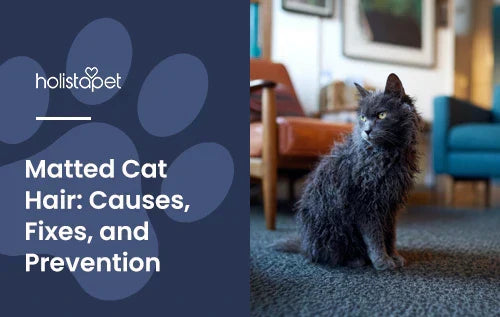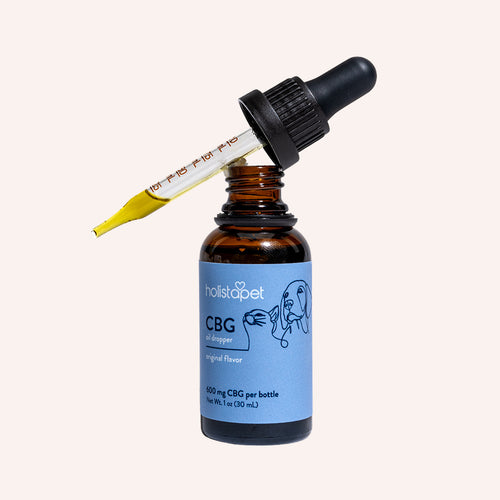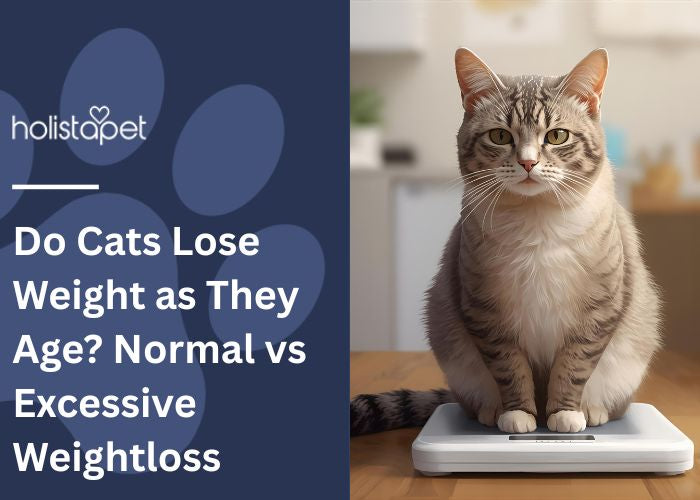Matted cat hair can turn a fluffy cuddle into a tangled mess fast. Those tight clumps pull at the skin and trap impurities. That's never a good combo for comfort and shine. But guess what? You can manage most mats with the right care and a little patience.
A cat's fur says a lot about their well-being. Smooth, glossy hair usually means a happy, comfy kitty. On the flip side, matted spots mean it's time for some grooming action. With a few smart habits, that rough coat can get back to soft and silky in no time.
What Is Matted Cat Hair?

Matted cat hair happens when loose fur tangles and tightens against the skin, forming stubborn clumps. These mats look messy and feel tight. Over time, they trap dirt, oil, and dead skin cells, making the fur rough and uncomfortable.
Mats usually start small, then tighten as the cat moves and grooms. The friction makes them harder to remove and sometimes painful. Long-haired cats and older felines with less flexibility tend to develop mats more often than their short-haired counterparts.
Why Matted Cat Fur Can Be Painful or Harmful
Matted fur can tug on the skin with every stretch, scratch, and movement. The tightness can cause soreness and irritation, especially in sensitive areas like the belly and behind the ears. When left untreated, mats can trap impurities, creating an uncomfortable situation that might lead to redness and swelling.
Some felines may even change their grooming habits because of the discomfort. They might avoid certain spots or lick too much around the mats. A proper care routine at home can keep their hair smooth, reduce pulling, and detect small mats before they turn into big problems.
Related Post: Cat Not Grooming? When To Worry and How To Respond
Common Causes of Matted Fur in Cats
Matted fur doesn't appear overnight. It usually builds up when everyday habits or hair types make tangles easy to form. For example, long-haired breeds like Maine Coons and Persians are more prone to mats because their hair can tangle up more easily. Short-haired felines can also develop mats, especially if they shed heavily. Let's look at some other causes:
- Lack of Regular Grooming. Skipping brush sessions lets loose fur bunch together.
- Long or Thick Fur Types. Dense coats make tangles easy to form.
- Shedding and Loose Hair Buildup. Old hair can twist into new growth.
- Moisture, Dirt, and Environmental Debris. Wet or dusty fur clings together fast.
- Health or Mobility Challenges. Older pets may struggle to groom properly.
- Stress or Behavioral Changes. Worried or upset cats may groom less often.
Remedies and Care Tips for Specific Causes
Keeping up with mats takes a mix of patience and smart care. Regular attention prevents tight tangles from forming and keeps a cat's hair soft and shiny. Each common cause of matting has an easy fix that can make life more comfortable for both pet and owner. Keep in mind these helpful tips:
- Grooming Routines for Long-Haired Cats. Brush daily with a metal comb or detangling brush to keep fur smooth.
- Managing Shedding and Loose Fur. Use a flea comb during shedding season to catch loose hair early.
- Keeping Fur Clean and Dry. Wipe dirt and moisture from the fur after outdoor time and messy play.
- Helping Cats with Mobility or Discomfort. Assist older cats with gentle brushing around hard-to-reach spots.
- Calming Upset or Worried Cats. Some soothing wellness products can help ease anxious feelings in cats. CBD (cannabidiol), for example, works with the feline endocannabinoid system (ECS), which is a natural network in the body that helps encourage calm and internal balance.
How To Safely Remove Matted Cat Hair
Removing matted cat hair takes a calm hand and the right tools. Rushing and pulling can make things worse, so gentle steps are important. It's best to start with a clean, dry fur and a comfortable space where your pet feels safe. Always follow these safe removal steps:
- Start Slow and Stay Gentle. Use your fingers to loosen small mats before using any tools.
- Use a Wide-Tooth Comb and Detangler Spray. These help separate hair without tugging and hurting the skin.
- Work from the Ends, Not the Roots. Hold the mat at the base and gently comb toward the tips to avoid pulling.
If the mat feels too tight or close to the skin, it's safer to stop and seek help from an expert pet groomer. Never force the removal of stubborn mats to avoid hurting your feline friend.
When To Trim and Why Never Cut Close to the Skin
Sometimes, trimming matted fur is the only safe way to help a kitty feel comfortable again. Trimming works best for thick and tight mats that won't loosen with gentle combing. A pair of battery-operated clippers is safer than scissors since scissors can accidentally cut the skin.
Always trim slowly and check the fur's depth as you go. Never cut too close to the skin. The mat may hide folds or tender spots, and cutting too deeply can cause irritation and small wounds. If the mat is large or sits near sensitive spots, a professional pet groomer or vet should handle it instead.
When To Call a Professional Groomer or Vet
Some mats are too tough and tight to handle at home. If brushing and trimming cause the cat visible discomfort, it's time to call an expert groomer or vet. They have the proper tools to remove mats safely without hurting the affected cat's skin and fur.
Professional help is also smart when mats form in sensitive parts like under the legs, around the tail, and on the belly. Severe matting can sometimes hide redness, swelling, and sores that need expert care. Getting help early keeps the hair smooth and prevents future tangles from becoming painful.
Preventing Matted Fur Before It Starts
Preventing matted fur is easier than fixing it later. Regular upkeep keeps your cat's fur smooth, soft, and free of tangles. Most felines benefit from short brushing sessions a few times a week, especially long-haired breeds with thick, silky hair.
A consistent routine helps remove unwanted particles in the hair before they form mats. Keep each session gentle and fun, so your cat feels calm and relaxed. Using the right tools, like a wide-tooth comb, detangler spray, and pet hair conditioner, can make brushing faster and more comfortable for both you and your feline companion.
Create a Simple At-Home Grooming Routine
A simple routine at home keeps matted cat hair from forming and helps your feline friend feel more comfortable. Brushing regularly removes loose fur and dirt before they clump together. Even short-haired cats benefit from a few quick strokes with a soft brush every week.
Set a calm tone by having sessions at the same time each day, ideally when your cat feels relaxed. Use a metal comb for long hair and a detangling brush for thick fur. Keep sessions short and reward your kitty afterward with treats or cuddles. Consistency helps keep fur smooth, skin clean, and cleaning time stress-free.
Support Coat Health With Proper Nutrition and Hydration
A cat's coat reflects what's happening inside their body. Good nutrition and steady hydration help keep the fur soft and less prone to tangling. Felines that drink enough water and eat balanced meals naturally shed less and have fewer mats.
Adding moisture-rich food and a water fountain can encourage better drinking habits. Look for high-quality cat food that supports skin and coat health with protein and natural fats. Consistent hydration and balanced meals work together to keep your cat's hair shiny and mat-free.
Manage Stress for Happier, Healthier Cats

A calm cat grooms more often and keeps their hair in better shape. Stress or nervous habits can make a feline either overgroom or stop cleaning themself altogether. Neither is good and can lead to tangled fur. Creating a relaxed home environment helps reduce anxious behaviors and supports healthier hair.
Keep routines steady and offer quiet spaces where your cat can rest. Playtime also helps release tension and build confidence. For extra calm, HolistaPet's CBD Oil for Cats can promote relaxation and balanced moods, making cleaning easier and more enjoyable for both you and your furry friend. Check out our Cat CBD Collection here.
When To Seek Professional Help
If the tangles are too tight, close to the skin, or cover large areas, it's time to visit a professional groomer or vet. They can remove mats without hurting your cat and check for redness, swelling, and irritation underneath.
Professional care is also smart if your pet shows discomfort when brushed or resists cleaning completely. Groomers use special tools and detangling methods that protect the skin while restoring the coat. Early help keeps mats from returning and leaves pets feeling fresh and much more comfortable.
Keeping Your Cat's Coat Soft, Shiny, and Mat-Free with HolistaPet
Soft, smooth hair starts with good care, and HolistaPet makes that easier. Our CBD Oil for Cats Collection helps promote calm grooming habits while supporting overall comfort. Felines that feel relaxed tend to clean up more consistently, which helps prevent tangles and mats before they form. Popular picks include:
- Original Flavor CBD Oil for Cats – gentle and natural for daily use.
- Salmon-Flavored CBD Oil for Cats – tasty and packed with soothing benefits.
- Chicken-Flavored CBD Oil for Cats – perfect for picky eaters.
- Bonus: CBD Cat Treats and CBD Calming Chews for Cats – easy, stress-free options.
HolistaPet products are carefully made from American-grown hemp, lab-tested for purity, and completely free of artificial additives. Every formula is broad-spectrum, plant-based, and cruelty-free, offering pet parents a trusted way to support feline comfort and relaxation.
FAQs About Bad Mats in Cats
Even the fluffiest kitties can get tangled fur now and then. Quick answers can make grooming a lot easier and help keep mats from coming back. Here's what most cat parents ask about matted fur and coat care.
What causes matted fur in cats?
Mats form when loose hair, oil, and dirt clump together and tighten against the cat's skin. Moisture and debris can also make the fur stick together, creating small mats that grow over time. Long-haired breeds and older felines are more likely to develop mats because of shedding and reduced grooming. Without regular brushing, these tangles can trap more impurities and make the surface rough. Regular grooming helps prevent buildup and keeps the fur free of knots.
Can matted cat hair hurt my cat?
Yes, matted cat hair can cause soreness and irritation if it pulls on the skin. Tight mats can make movement uncomfortable, especially in sensitive spots like the belly and legs. Over time, the tension can lead to redness and swelling under the tangled fur. Cats might avoid physical contact where the mats sit because they feel tender. Removing mats early keeps kitties much more comfortable.
Should I shave my cat if they’re severely matted?
Shaving might be necessary when mats cover large areas and sit close to the skin. However, it's safest to have a professional groomer or vet handle intense matting. Scissors and clippers can accidentally cut the affected cat's skin if used incorrectly. Experts know how to remove mats carefully while protecting sensitive spots. Once the hair is properly shaved, regular brushing should follow to prevent mats from forming again.
Do indoor cats get matted fur, too?
Yes, indoor cats can still get matted fur even if they never go outside. Long fur, shedding, and skipped grooming sessions can all cause tangles. Dust, dander, and natural oils can stick to loose hair and form small mats over time. Regular brushing removes that buildup and helps keep the coat clean.
How often should I groom my cat to prevent mats?
Most cats need brushing several times per week to keep their hair in good shape. Long-haired kitties often need daily brushing. A pet hair conditioner and wide-tooth comb can make grooming smoother and more comfortable. Regular brushing removes loose fur, dirt, and dead skin cells before they tangle.
When should I see a vet about matted fur?
Visit a vet if the mats are too tight, painful, or cover sensitive areas like the belly or tail. Mats that cause redness, swelling, and irritation should always get checked by a professional. Vets can safely remove the mats and treat any affected skin underneath. They can also look for underlying causes, such as reduced mobility, discomfort, or allergies. Early care prevents severe matting and keeps the hair healthy and comfortable.
Final Thoughts: The Power of a Little Extra Care
Soft, tangle-free hair comes down to steady care and the right tools. Brushing regularly, keeping the fur clean, and checking for small tangles go a long way toward preventing discomfort. Even a few minutes of gentle grooming each day helps maintain a shiny, smooth coat that looks and feels great.
When mats do show up, patience and proper technique should be your go-to approach. Starting early and paying attention to comfort can stop bigger problems before they form. For extra support, HolistaPet's CBD oil for cats can promote relaxation during grooming, keeping both kitty and owner stress-free while maintaining a healthy, mat-free coat.


 CBD Oil for Cats - Fast Acting
CBD Oil for Cats - Fast Acting
 CBD Cat Treats - Easy Dose
CBD Cat Treats - Easy Dose
 CBD Calming Chews for Cats - Highly Rated
CBD Calming Chews for Cats - Highly Rated
 CBG Oil for Dogs and Cats - Loved by Thousands
CBG Oil for Dogs and Cats - Loved by Thousands





Leave a comment
All comments are moderated before being published.
This site is protected by hCaptcha and the hCaptcha Privacy Policy and Terms of Service apply.